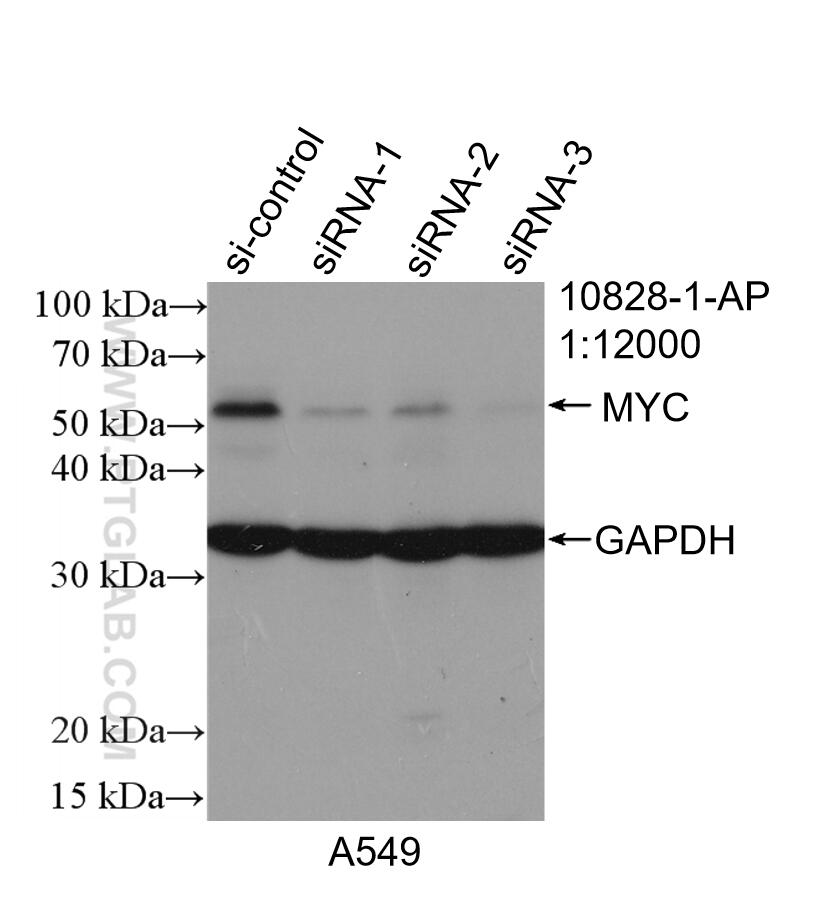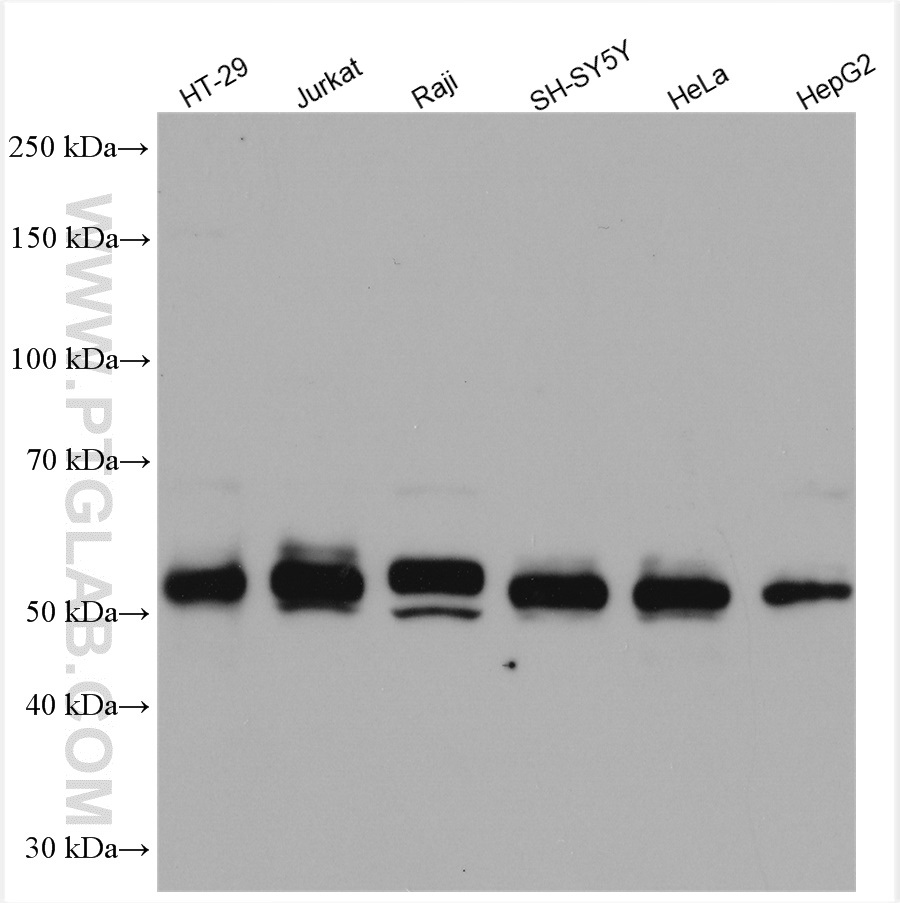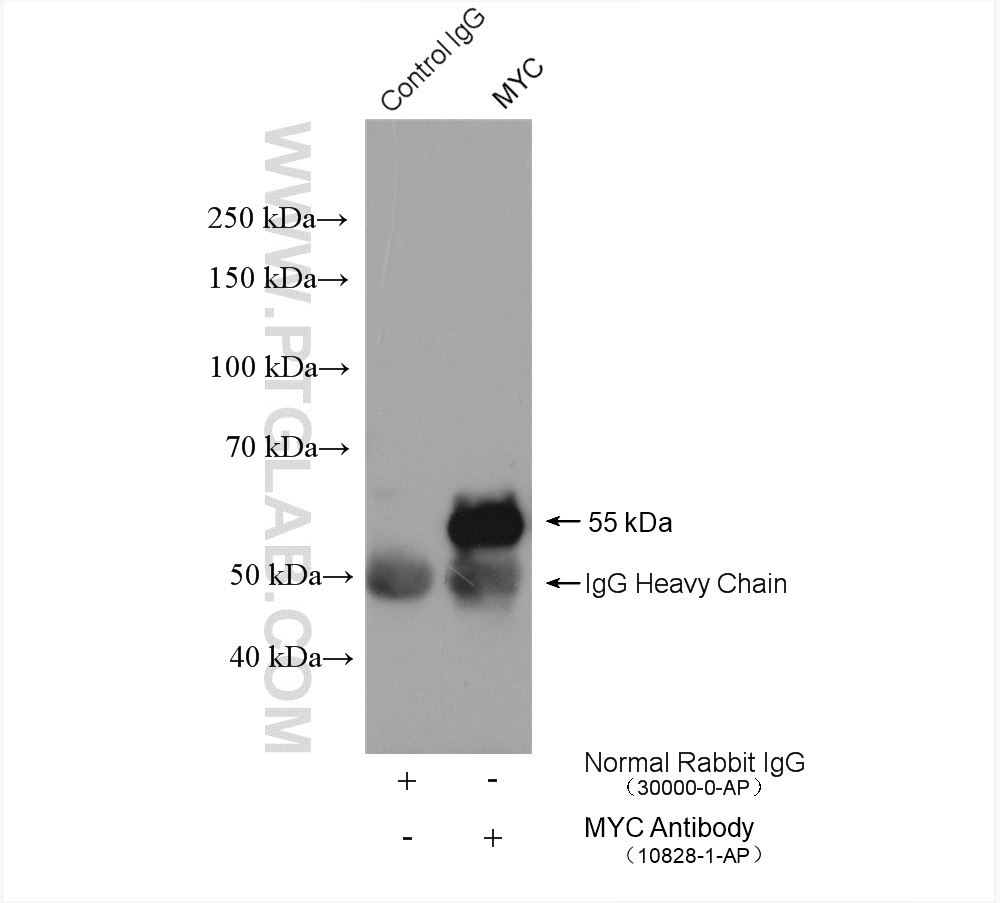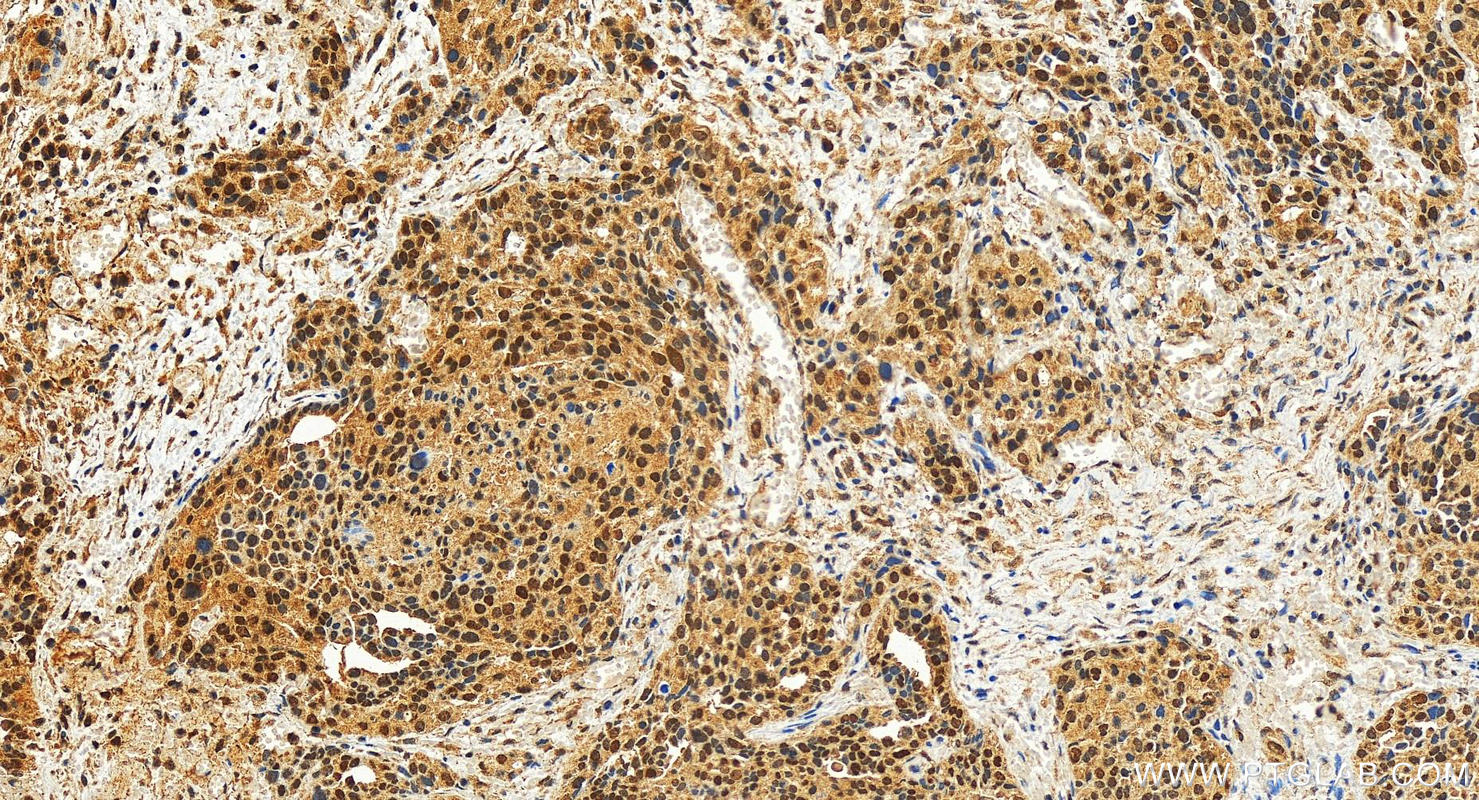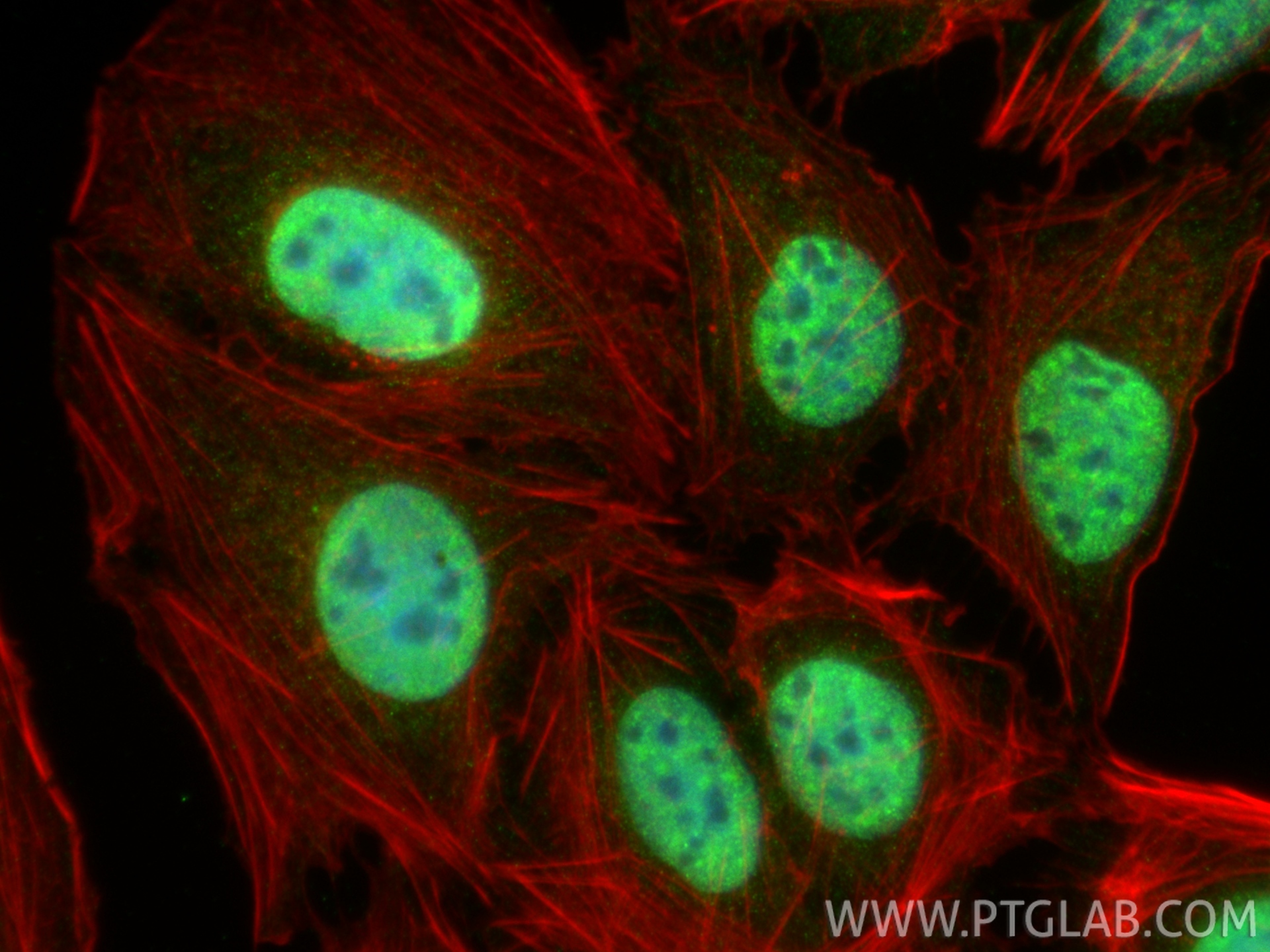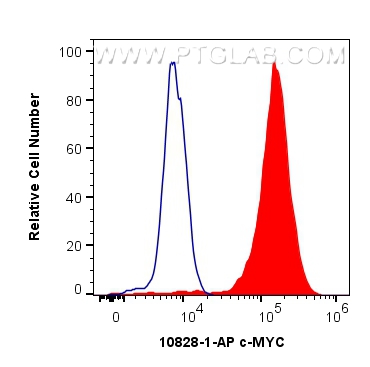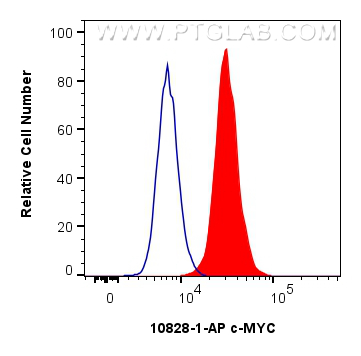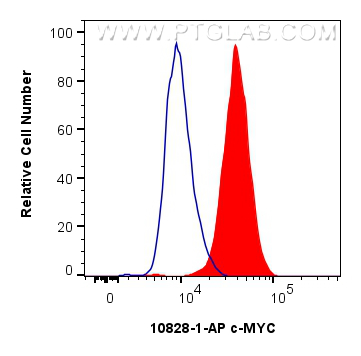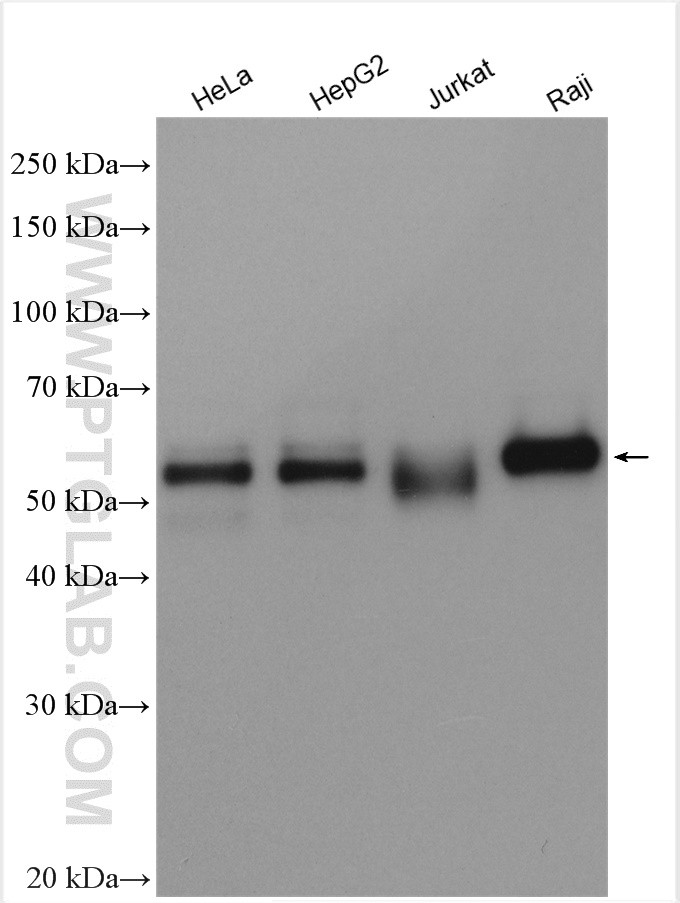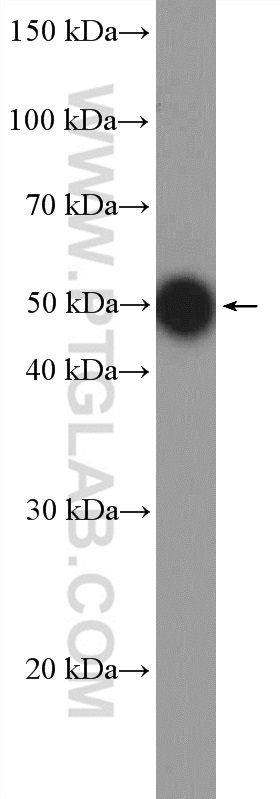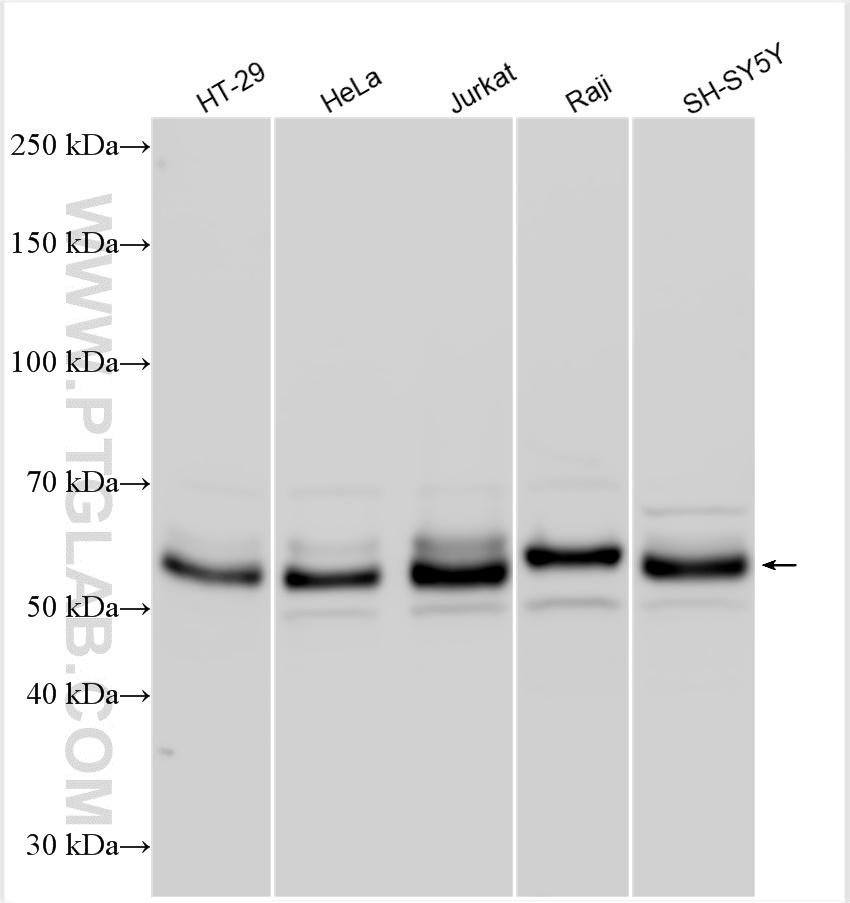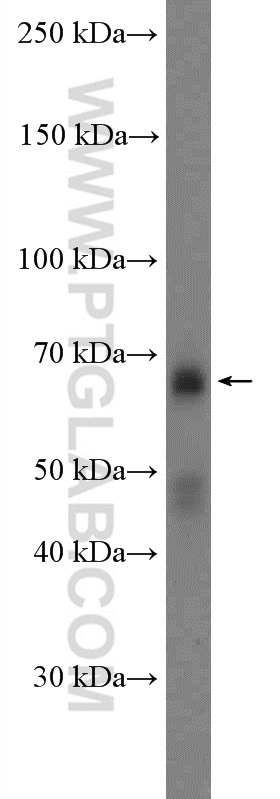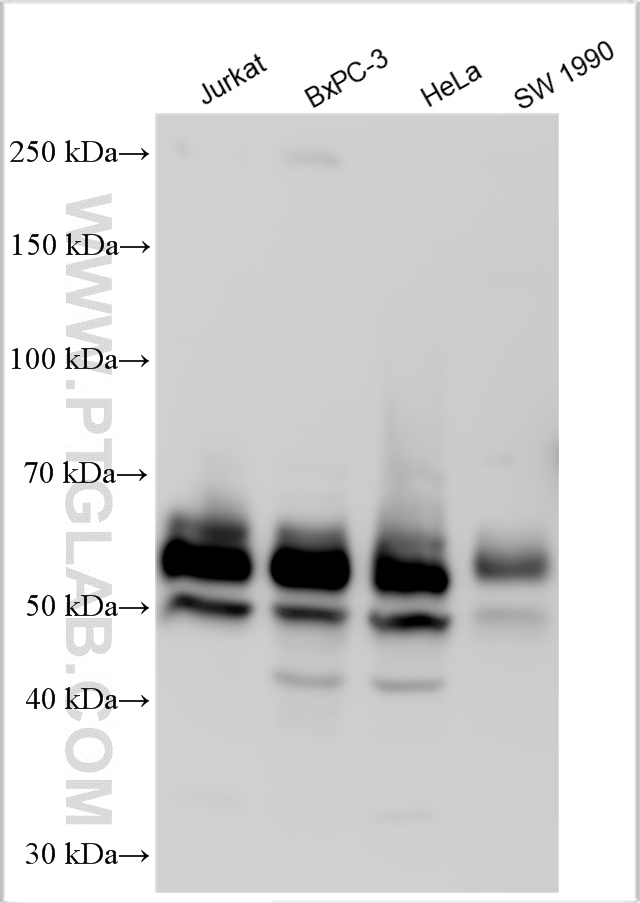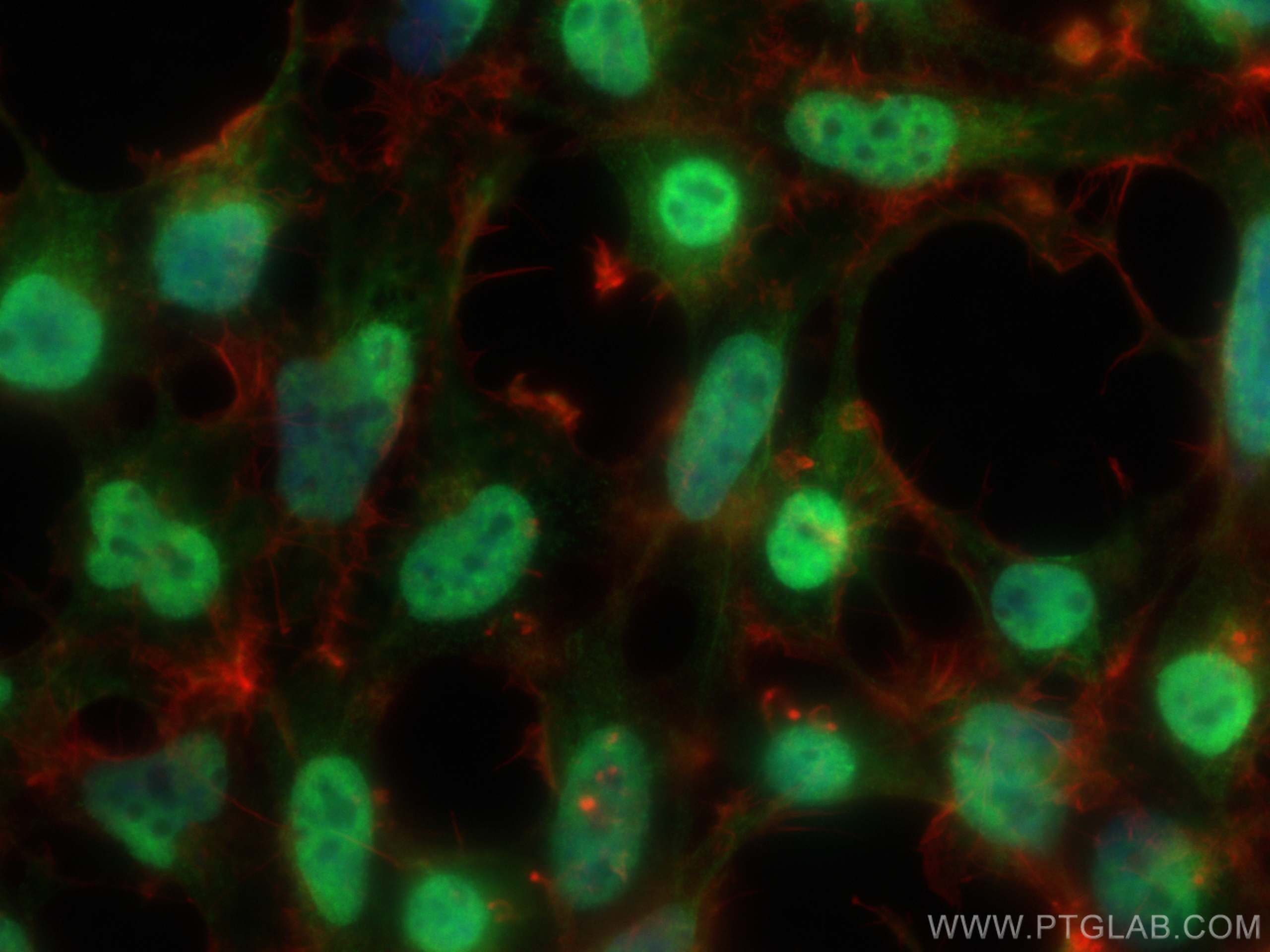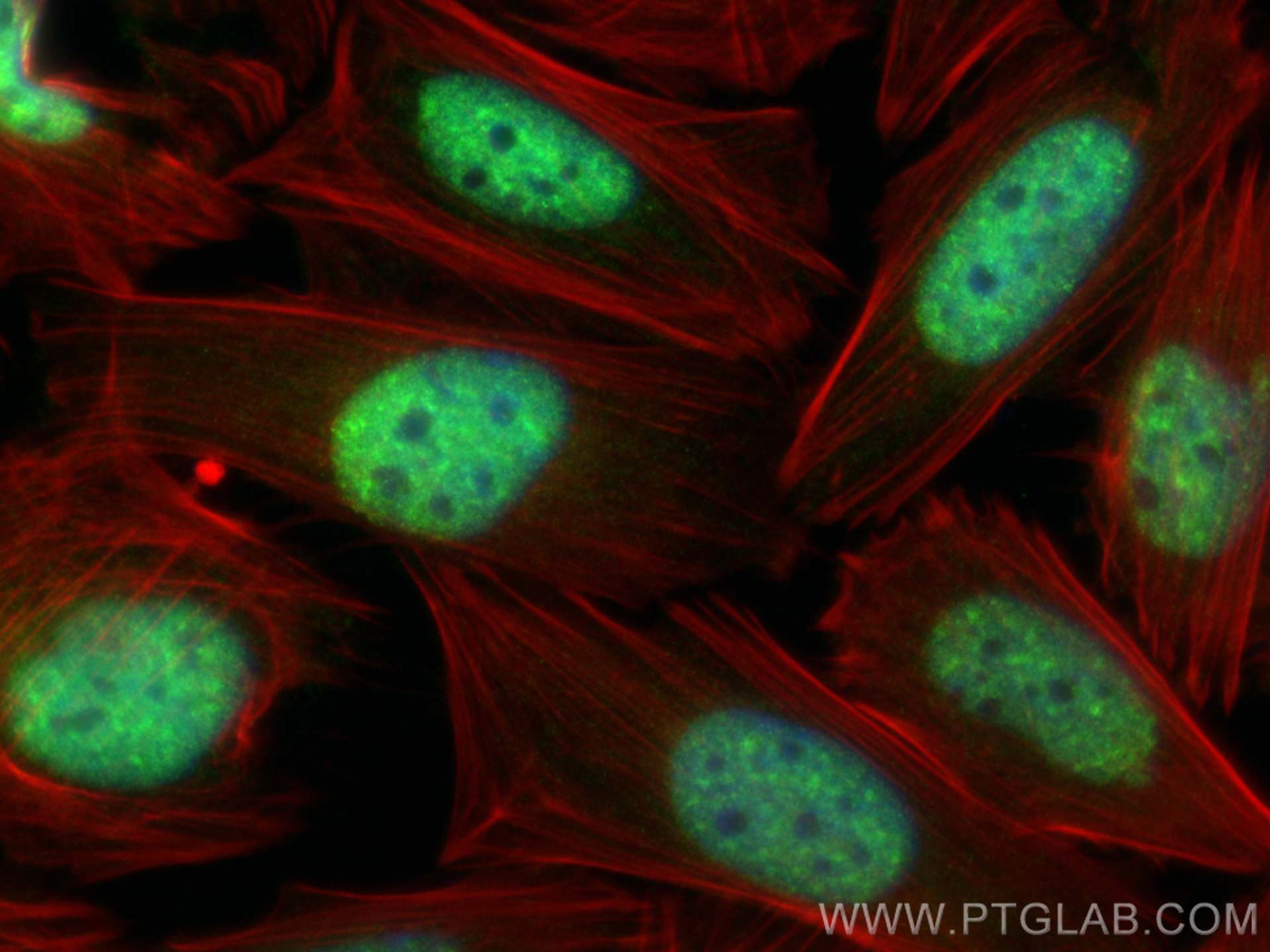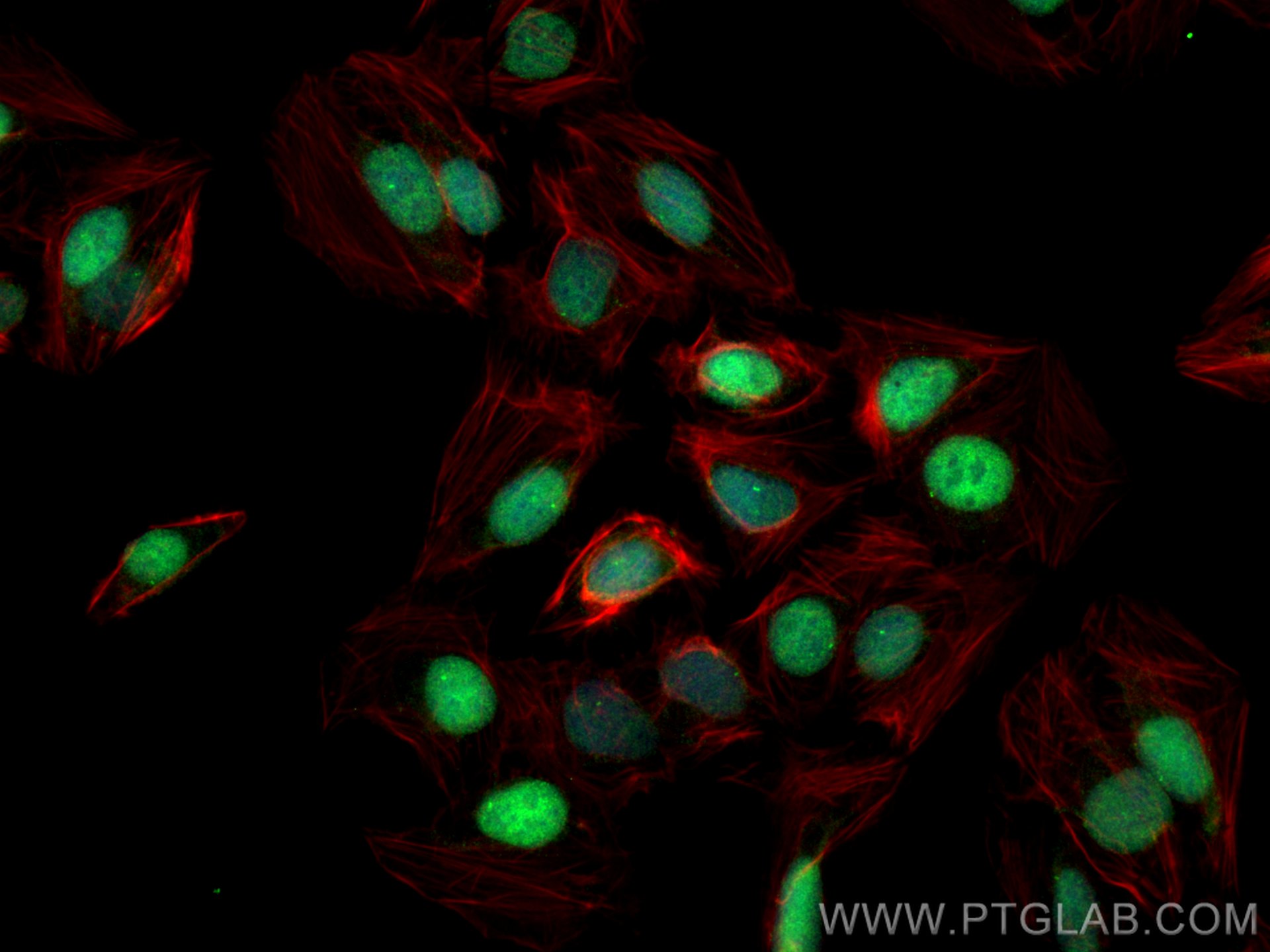验证数据展示
经过测试的应用
| Positive WB detected in | HT-29 cells, Jurkat cells, HeLa cells, A549 cells, HL-60 cells, human placenta tissue, Raji cells, SH-SY5Y cells, HepG2 cells, BxPC-3 cells, SW 1990 cells, Jurkat cells and Raji cells. |
| Positive IP detected in | MCF-7 cells |
| Positive IHC detected in | human ovary cancer tissue Note: suggested antigen retrieval with TE buffer pH 9.0; (*) Alternatively, antigen retrieval may be performed with citrate buffer pH 6.0 |
| Positive IF/ICC detected in | U2OS cells, HEK-293 cells, Saos-2 cells |
| Positive FC (Intra) detected in | HeLa cells, NCCIT cells |
This antibody is not for the detetion of MYC-tag.
推荐稀释比
| 应用 | 推荐稀释比 |
|---|---|
| Western Blot (WB) | WB : 1:2000-1:12000 |
| Immunoprecipitation (IP) | IP : 0.5-4.0 ug for 1.0-3.0 mg of total protein lysate |
| Immunohistochemistry (IHC) | IHC : 1:500-1:2000 |
| Immunofluorescence (IF)/ICC | IF/ICC : 1:200-1:800 |
| Flow Cytometry (FC) (INTRA) | FC (INTRA) : 0.40 ug per 10^6 cells in a 100 µl suspension |
| It is recommended that this reagent should be titrated in each testing system to obtain optimal results. | |
| Sample-dependent, Check data in validation data gallery. | |
产品信息
10828-1-AP targets c-MYC in WB, IF/ICC, FC (Intra), IP, CoIP, ChIP, RIP, ELISA, EMSA applications and shows reactivity with human samples.
| 经测试应用 | WB, IF/ICC, FC (Intra), IP, ELISA Application Description |
| 文献引用应用 | WB, IF, IP, CoIP, chIP, RIP, EMSA |
| 经测试反应性 | human |
| 文献引用反应性 | human, mouse, rat, pig, chicken, sheep, silkworm, p. lilacinum |
| 免疫原 |
CatNo: Ag1263 Product name: Recombinant human MYC protein Source: e coli.-derived, PGEX-4T Tag: GST Domain: 16-454 aa of BC000141 Sequence: MPLNVSFTNRNYDLDYDSVQPYFYCDEEENFYQQQQQSELQPPAPSEDIWKKFELLPTPPLSPSRRSGLCSPSYVAVTPFSLRGDNDGGGGSFSTADQLEMVTELLGGDMVNQSFICDPDDETFIKNIIIQDCMWSGFSAAAKLVSEKLASYQAARKDSGSPNPARGHSVCSTSSLYLQDLSAAASECIDPSVVFPYPLNDSSSPKSCASQDSSAFSPSSDSLLSSTESSPQGSPEPLVLHEETPPTTSSDSEEEQEDEEEIDVVSVEKRQAPGKRSESGSPSAGGHSKPPHSPLVLKRCHVSTHQHNYAAPPSTRKDYPAAKRVKLDSVRVLRQISNNRKCTSPRSSDTEENVKRRTHNVLERQRRNELKRSFFALRDQIPELENNEKAPKVVILKKATAYILSVQAEEQKLISEEDLLRKRREQLKHKLEQLRNSCA 种属同源性预测 |
| 宿主/亚型 | Rabbit / IgG |
| 抗体类别 | Polyclonal |
| 产品类型 | Antibody |
| 全称 | v-myc myelocytomatosis viral oncogene homolog (avian) |
| 别名 | MYC, bHLHe39, c Myc, Class E basic helix-loop-helix protein 39, MRTL |
| 计算分子量 | 49 kDa |
| 观测分子量 | 62-65 kDa, 50 kDa |
| GenBank蛋白编号 | BC000141 |
| 基因名称 | MYC |
| Gene ID (NCBI) | 4609 |
| RRID | AB_2148585 |
| 偶联类型 | Unconjugated |
| 形式 | Liquid |
| 纯化方式 | Antigen affinity purification |
| UNIPROT ID | P01106 |
| 储存缓冲液 | PBS with 0.02% sodium azide and 50% glycerol, pH 7.3. |
| 储存条件 | Store at -20°C. Stable for one year after shipment. Aliquoting is unnecessary for -20oC storage. |
背景介绍
Function
c-Myc (also known as Myc), together with l-Myc and n-Myc, belongs to the Myc family of transcription factors. c-Myc has a basic helix-loop-helix leucine zipper domain and through heterodimerization can bind and regulate the transcriptional activity of genes, either by repression or activation. It is a key player in the regulation of cell growth and cell cycle progression and acts as a proto-oncogene.
Tissue specificity
c-Myc is ubiquitously expressed in almost all cell types and its expression positively correlates with tissue proliferative capacity. c-Myc is also expressed during embryogenesis and is upregulated in many cancer types.
Involvement in disease
· Upregulated in many cancer types, especially in aggressive, poorly differentiated tumors.
· Mutations in the MYC gene and breakpoint translocations within the MYC gene cause Burkitt lymphoma.
Isoforms
There are 3 different isoforms of c-Myc: c-Myc1, c-Myc2, and c-MycS (PMID: 16260605). They differ in molecular size, can be preferentially expressed during cell growth, and are reported to be functionally distinct. The 50kDa band recognized by antibody is the native form of MYC, while the other bands, between 60-70kDa, are the phosphorylated form of MYC (PMID: 12189186).
Post-translational modifications
c-Myc is subject to various post-translational modifications, including phosphorylation, acetylation, and ubiquitinylation (PMID: 16987807), which regulate its activity.
Cellular localization
c-Myc localizes to the nucleus but can also be present in the cytoplasm of certain cancer types.
实验方案
| Product Specific Protocols | |
|---|---|
| IF protocol for c-MYC antibody 10828-1-AP | Download protocol |
| IHC protocol for c-MYC antibody 10828-1-AP | Download protocol |
| IP protocol for c-MYC antibody 10828-1-AP | Download protocol |
| WB protocol for c-MYC antibody 10828-1-AP | Download protocol |
| Standard Protocols | |
|---|---|
| Click here to view our Standard Protocols |
发表文章
| Species | Application | Title |
|---|---|---|
Signal Transduct Target Ther MDIG-mediated H3K9me3 demethylation upregulates Myc by activating OTX2 and facilitates liver regeneration
| ||
Signal Transduct Target Ther Overexpression of CIP2A is associated with poor prognosis in multiple myeloma. | ||
Gastroenterology Nucleolar HEATR1 upregulated by mTORC1 signaling promotes hepatocellular carcinoma growth by dominating ribosome biogenesis and proteome homeostasis | ||
Cancer Cell p53 Is a Master Regulator of Proteostasis in SMARCB1-Deficient Malignant Rhabdoid Tumors.
| ||
Cell Metab Efferocytosis induces macrophage proliferation to help resolve tissue injury.
|

